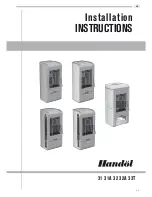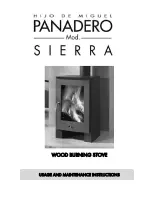
flueways and chimney are completely clear. Empty the ashes.
Place two or three firelighters close together, or screwed-up paper
covered with dry sticks, at the back of the grate and light them.
When they are burning well gently fill the fire with dry fuel, close
the door and set the air control slides to the 'high' (right) position.
When the fire is burning well, move the controls to the lowest
practical setting.
FILLING:
Don't fill above the level shown in
the diagram.
CONTROL
How fast the fire burns depends
on how much air reaches the fuel. The
stove has two air controls, one below the
window ('primary' 1) and one above
('airwash control 2). Move the top slides to
the right for highest output, to the left for
'low'. The lower control is 'in' for low and
'out' for high. They can get
very
hot, so
move them only with the handle supplied.
Our tests indicate highest efficiency on
wood with the primary (1)
control closed
and the airwash (2) at 2/3 open, but the
precise settings to suit your fuel and chimney can only be found
from experience.
EMPTYING ASHES:
Use the tool or glove to open the door and ...
Mutifuel model:
Stir the fire with a poker. Use the tool to lift out
the ashpan. Never allow ash to build up so as to touch the
underside of the grate.
Wood-only model:
Empty excess ash
using a spoon or scoop only when it is so full as to risk spilling
over the firebars.
All:
Remember to let ash cool before disposing
in plastic sacks or dustbins.
KEEPING THE WINDOW CLEAN
Simply operating the stove for a
few minutes at high output will often burn-off any deposits left by
tarry or wet fuel. Severe stains can be removed when cold with a
domestic bleach cleaner. The window is not glass but a
transparent ceramic, it may develop tiny hairline cracks, these are
harmless, and a characteristic of the toughest and most heat-
resistant material known. Reduce the risk of staining by using only
very dry
fuel.
OPENING THE DOOR
This stove is designed to be operated only
with the door closed. Open the door very slowly to minimise fume
emission and prevent hot fuel falling out. Remember that the
whole stove becomes extremely hot.
SUMMER SHUT DOWN:
Before a long period of non-use, empty
fuel and ash, remove the throat plate and leave all the air controls
open to allow ventilation to reduce condensation.
FUELS
Do avoid dusty materials like sawdust, they can burn far to
violently.
SMOKE CONTROL:
In certain areas special rules apply to reduce
smoke nuisance. Check with your local authority.
WOOD
only emits as much carbon to the atmosphere as the tree
took in when growing, so wood is considered the 'carbon neutral'
fuel. When wood is cut down its cells are full of water. Burning
such wet or 'green' wood wastes heat in making steam and
produces flammable, acidic tars which will cling to, and rapidly
damage, your stove and chimney. Split logs will typically take two
years to become reasonably dry, round logs very much longer.
Cracks in the ends, a hollow sound when tapped and bark falling
away are all signs that a log may be ready for use. The fine, white
residue produced when wood burns is not ash, but the remains of
cell walls which can burn if kept hot enough, so don't de-ash the
fire until absolutely necessary when using wood.
For best performance, and
always
for low smoke emission:
Split logs lengthways for drying
Use logs no bigger than about
100mm x 250mm
Ensure logs are absolutely dry
(less than 20% moisture)
Fill the stove criss-cross, so air
can circulate between logs.
Fill 'little and often'
Always have the airwash control (2) at least a little open.
When first lighting, or reviving a fire from embers, use only very
small, thin, dry, sticks.
JOINERY WASTE
Dry wood offcuts will burn well, but don't expect
softwood waste to burn as cleanly or for as long as hardwood logs.
OTHER FUELS
With the multi-fuel grate and ashpan fitted, this
stove can burn a wide range of other fuels, including the full range
of authorised smokeless fuels, as recommended by your fuel
supplier and permitted in your region.
HOUSEHOLD WASTES
Some plastics give off toxic fumes when
burned and remember that batteries and aerosols explode! The
stove is not an incinerator, so only ever use the recommended
fuels and NEVER use liquid fuels in any form.
DO NOT USE
Don't use non-authorised 'smokeless fuels' or
'petcoke' - these are often made with dangerous high-suphur oil
waste and will rapidly damage your stove. Don't use cheap, raw
bituminous coal, sometimes sold as 'Polish Coal'.
PROBLEMS?
Problems like those listed here are usually due to some difficulty
with the installation, chimney or fuels, so please check back
through this leaflet carefully. If necessary seek specialist advice.
SMOKE FROM THE CHIMNEY
It is quite normal for a little smoke
to be emitted from the chimney when the fire is cold. Use only
VERY dry wood or smokeless fuels.
DAMAGED LINERS
The Portway stove gets very, very hot inside,
it is quite usual for the replaceable liners to crack or craze. They
need only be replaced when they have almost completely
disintegrated. Help them last longer by using only
very
dry
fuel.
POOR HEAT OUTPUT:
A stove can heat a typical room of
about
12m³ volume for each kW of output, so a 5kW model can heat up
to (12 x 5) 63m³, a room of about 5m square. The actual size
depends on the insulation and air-change ratio of the room. To
attempt to heat a larger room will result in excessive fuel
consumption and damaging overheating.
LACK OF CONTROLLABILITY
Wood and some other fuels may
burn excessively until the gases in them have been used up. You
can reduce this effect by making sure that the fire is set to 'low' for
a while before refuelling and checking that the door seals fully.
Adjust the heat output by how much fuel you put on, as well as by
using the controls.
CONDENSATION
onto cool surfaces inside the stove can be
severe if fuel is in any way damp.
Use only very dry fuel.
OVER-FIRING:
It is possible to leave the fire too long with the
controls set too high leading to 'over firing', seen as glowing metal
parts, excessive chimney temperature and risk of parts failing or
chimney fires. Always set controls to the lowest practical setting. A
chimney thermometer, from your local stove shop, can help.
SMOKE COMING INTO ROOM
Fumes are poisonous- smoke
emission must NEVER be tolerated, causes might be:
NEW STOVE: There is often a smell and sometimes visible fumes
as the paint cures. This normally stops after an hour or so.
INADEQUATE SEALS: Are all flue pipes and connectors
absolutely
gas-tight? Even the tiniest crack or gap can spoil the
draught. Does an inset appliances fully seal against the fireplace?
BLOCKED THROAT PLATE: Has soot and ash collected on the
'throat plate' above the inner back part of the firebox?
UNSUITABLE, BLOCKED OR UN-SWEPT CHIMNEY: The first
requirement for correct operation is a sound chimney. Check the
requirements earlier in this document and in any case of doubt
engage a professional sweep or chimney engineer.
POOR AIR SUPPLY: Lack of air to the fire is a common cause of
smoking and poor performance. Air supply problems may be
worse in certain wind conditions (often incorrectly ascribed to
'downdraught', which is in fact very rare), where air can be sucked
out of the room.
DOWNDRAUGHT: Wind can blow
down
a chimney if there is
something higher nearby such as a tree, hill or high building.
Fitting an anti-downdraught cowl to the chimney top can cure this.
Types which cannot be swept through are not recommended.
POOR CHIMNEY DRAUGHT- Chimney draught in use MUST be
at least 12Pa.
3






















